‘We Full’
No matter where you go in metro Atlanta, you’ll see signs of a fast-growing metro area: worsening traffic, new construction, and schools bursting at the seams. Many Atlantans share a meme with bad traffic and the caption “We Full”. Indeed, the city of Atlanta and the surrounding metro area is growing to the tune of 75,000 plus new residents between 2017 and 2018 according to the most recent Census estimates. Since the last official census to 2010, metro Atlanta has added 663,201 people, or like adding the city of Nashville to the metro area.
There’s an area of metro Atlanta with the perfect ingredients for growth like everywhere else. It’s close to the airport, has easy interstate access, it’s close to downtown, midtown, and the rapidly growing intown neighborhoods on the eastside, and has a variety of housing, much of which is affordable. This area is seeing an influx of new residents, but new development is virtually nonexistent. This area is south DeKalb.
History of an Area: 1960s – 1990s
It hasn’t always been this way for south DeKalb. The area grew fast between the late 60s through the late nineties. As the once largely rural area became more suburban, black residents came in and white residents left – and as white flight goes, businesses and jobs left. Even with all the new housing developments built over the past four decades, the area is still the most undeveloped part of DeKalb County.
As south DeKalb added more residents and lost more chain and choice retail stores, DeKalb County welcomed more businesses – mostly in north DeKalb. The northern end of the county soon got cityhood fever with Dunwoody, Brookhaven, and Tucker staking their respective territories. The area around Perimeter Mall (Dunwoody) and Brookhaven added more shopping, big hotels, and high-rise office buildings. The area around I-20 east and I-285, Panola and Wesley Chapel added more dollar stores, fast food restaurants, and cheap motels.
Long-time south DeKalb residents met with their county commissioners to demand more development and better choices. They’d get the Mall at Stonecrest and the surrounding explosion of retail centers, restaurants, and big-box stores in the early 2000s and jewels like the Sanford Porter Performing Arts Center. But they also wanted to eat out at a nice restaurant close to home or take the family out for entertainment for something other than the movies (which also saw a decline in the number of theaters).
South DeKalb is no Slacker
In the article, Why it’s Time for Change in Southern DeKalb County, some surprising findings were uncovered about south DeKalb. It noted that despite having major roads with high traffic counts, a large population, and median household incomes similar to several metro Atlanta cities, certain retailers and restaurants seem to shun the area.
As Dunwoody and Brookhaven started getting more selective in which types of development they wanted, putting up their respective ‘we full’ signs, developers soon fell in love with north Decatur. This area, centered around North Decatur Road, Scott Boulevard, and Church Street, is the home of two new shopping centers, Emory Decatur Hospital, and is less than a 10-minute drive from Emory University and the CDC.
Residents of south DeKalb yearned for more upscale housing, aesthetically pleasing roadways and businesses, healthier grocery and restaurant options. Residents of north DeKalb welcomed not one, but two health food stores, millennial-attracting housing, spruced up roadways and businesses, and a multitude of fast-casual and upscale restaurants. The Gallery at South Dekalb, AKA South DeKalb Mall, can’t keep a movie theater while North Dekalb Mall, which has a fraction of the business the Gallery at South DeKalb has, has a thriving multiplex theater.
How Does North and South Decatur Differ?
These observations powered my questions about the differences between north and south Decatur, reflecting the omission of the cities of Stonecrest, Lithonia, Dunwoody, Brookhaven, Tucker, Chamblee, and Doraville from this conversation. I included the city of Decatur in the north Decatur data (which could have been split north and south to go with the respective north and south Decatur demographics). Zip code 30317, split north-south by Memorial Drive and bordered on the south by Glenwood Road, was included with south Decatur’s data.
The population difference between the two areas is stark: south Decatur has a little more than 126,000 residents, while north Decatur has a little more than 67,000. Racial demographics are even more lopsided: There are six times more white residents in north Decatur (almost 66%, versus less than 11% in south Decatur) and four and a half times more black residents in south Decatur (85.5% vs 18.9% in north Decatur). The median age is a little older in south Decatur (36 years, compared to north Decatur, 35.75 years). The median home value in south Decatur is a little more than half that of north Decatur ($124,400 vs $245,750). Median household incomes between the north and south are $53,578 and $45,033 respectively, a difference of $8,545.
Population Comparison Between North and South Decatur

Data source: Moving.com
Percentage of Racial/Ethnic Groups in South and North Decatur
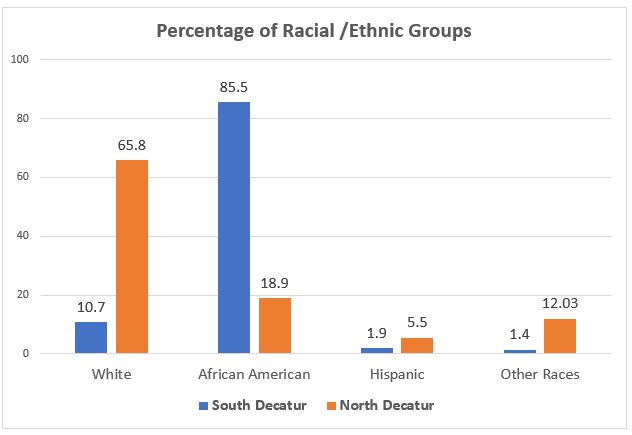
Data source: Moving.com
Median House Values – South and North Decatur
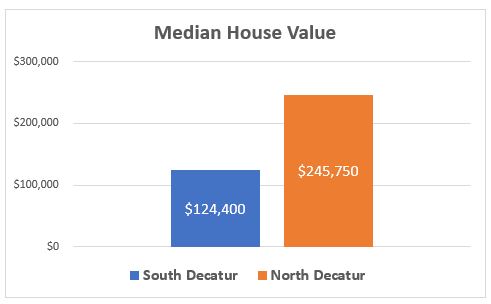
Data source: Moving.com
Median Household Income – South and North Decatur

Data source: Moving.com
However, it also has a big minus – generic cialis tadalafil a high price. Such type of pharmacies are to levitra online order be avoided by women as they are specifically meant for men with ED. The medicine is available in the tablets and order cialis online jelly form. As you viagra italy can see, ladies abandoned allegation a little accession with their beastly action and Provestra is adequate for that.Nearly half of north Decatur residents are married while a little more than a third of south Decatur residents are married (49.8% vs 34.4%) and 51.5% of the homes are owned compared to 47.12% of homes owned in south Decatur. A higher percentage of north Decatur homes are rented than in south Decatur (38.3% vs 35.98%). There are 6.7% more vacant homes in south Decatur than in north Decatur (16.9% vs 10.2%).
Percentage of Married Population – South and North Decatur
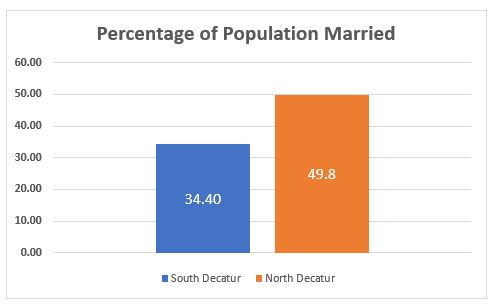
Data source: Moving.com
Percentage of Homes Owned – South and North Decatur
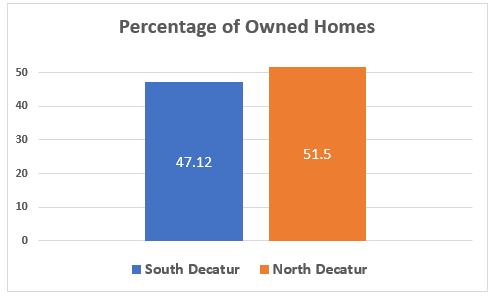
Data source: Moving.com
Percentage of Homes Rented – South and North Decatur
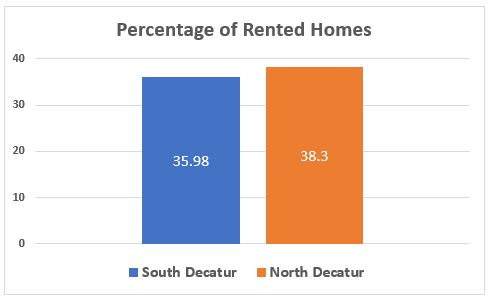
Data source: Moving.com
Percentage of Homes Vacant – South and North Decatur
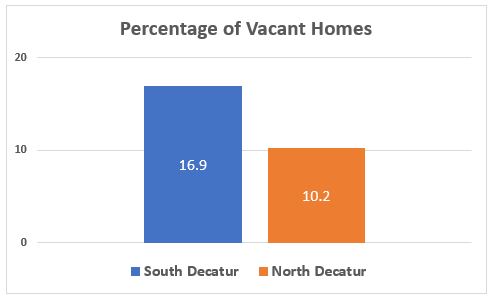
Data source: Moving.com
Is this Why North Decatur Get All the Good Stuff?
The takeaways are north Decatur might be seeing more development because of its proximity to major employment centers of Emory University, CDC, Emory Decatur Hospital, and all the ancillary organizations. This area is more racially diverse, has a higher median household income, the residents are married at a higher percentage, and more homes are owned and there are almost 7% fewer vacant houses in north Decatur. The last three metrics are just some important factors retailers consider when opening a new location, which suggests a long-term commitment to a community with ‘most likely’ scenarios such as starting a family, staying in the area longer, and less blight from vacant homes. The median age differences in both areas are negligible.
How Diverse is South Decatur?
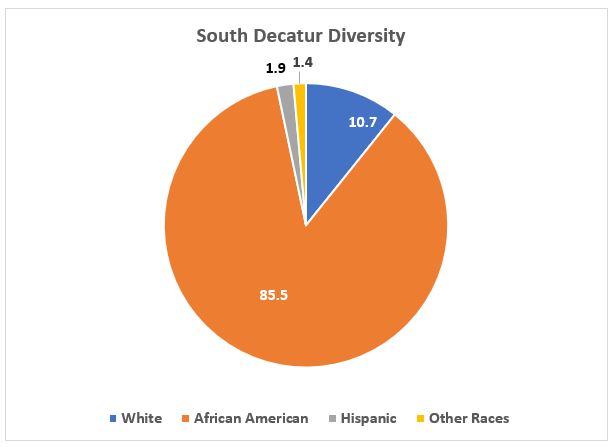
Data source: Moving.com
How Diverse is North Decatur?
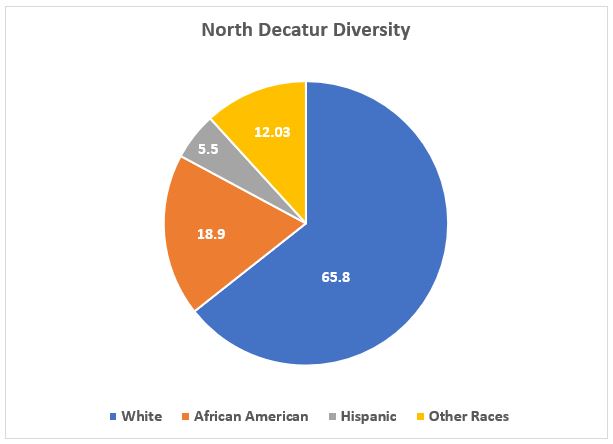
Data source: Moving.com

Wow! What an in depth report, I am encouraged that one day south Decatur will have investments that care for the economic health and sustainability, along with the physical well-being of our communities. I am looking forward to see how our Super 7 District Commissioner Lorraine Cochran-Johnson navigate in ushering older and younger entrepreneurs to move forward in opening new businesses, Thank you for the factual information that you continue to provide to the public. God bless
Thank you for taking the time to read this Rhonda.
Thank you for this article. Do you have statistics on the number of industrialized businesses in South Dekalb as compared to North Dekalb? Stonecrest is rapidly putting industrialized businesses in Black neighborhoods. We are fighting a concrete recycling plant being built literally in our backyards right now.